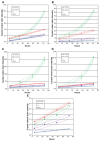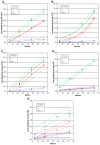Decreased bacteria activity on Si₃N₄ surfaces compared with PEEK or titanium
- PMID: 22973102
- PMCID: PMC3439860
- DOI: 10.2147/IJN.S35190
Decreased bacteria activity on Si₃N₄ surfaces compared with PEEK or titanium
Abstract
A significant need exists for orthopedic implants that can intrinsically resist bacterial colonization. In this study, three biomaterials that are used in spinal implants--titanium (Ti), polyether-ether-ketone (PEEK), and silicon nitride (Si₃N₄)--were tested to understand their respective susceptibility to bacterial infection with Staphylococcus epidermidis, Staphlococcus aureus, Pseudomonas aeruginosa, Escherichia coli and Enterococcus. Specifically, the surface chemistry, wettability, and nanostructured topography of respective biomaterials, and the effects on bacterial biofilm formation, colonization, and growth were investigated. Ti and PEEK were received with as-machined surfaces; both materials are hydrophobic, with net negative surface charges. Two surface finishes of Si₃N₄ were examined: as-fired and polished. In contrast to Ti and PEEK, the surface of Si₃N₄ is hydrophilic, with a net positive charge. A decreased biofilm formation was found, as well as fewer live bacteria on both the as-fired and polished Si₃N₄. These differences may reflect differential surface chemistry and surface nanostructure properties between the biomaterials tested. Because protein adsorption on material surfaces affects bacterial adhesion, the adsorption of fibronectin, vitronectin, and laminin on Ti, PEEK, and Si₃N₄ were also examined. Significantly greater amounts of these proteins adhered to Si₃N₄ than to Ti or PEEK. The findings of this study suggest that surface properties of biomaterials lead to differential adsorption of physiologic proteins, and that this phenomenon could explain the observed in-vitro differences in bacterial affinity for the respective biomaterials. Intrinsic biomaterial properties as they relate to resistance to bacterial colonization may reflect a novel strategy toward designing future orthopedic implants.
Keywords: anti-infective; biofilm; nanostructure; protein adsorption; silicon nitride.
Figures





Similar articles
-
Anti-infective and osteointegration properties of silicon nitride, poly(ether ether ketone), and titanium implants.Acta Biomater. 2012 Dec;8(12):4447-54. doi: 10.1016/j.actbio.2012.07.038. Epub 2012 Jul 31. Acta Biomater. 2012. PMID: 22863905
-
Bacteriostatic behavior of surface modulated silicon nitride in comparison to polyetheretherketone and titanium.J Biomed Mater Res A. 2017 May;105(5):1521-1534. doi: 10.1002/jbm.a.35987. Epub 2017 Mar 20. J Biomed Mater Res A. 2017. PMID: 28000413
-
Bacterial adhesion to orthopaedic implant materials and a novel oxygen plasma modified PEEK surface.Colloids Surf B Biointerfaces. 2014 Jan 1;113:213-22. doi: 10.1016/j.colsurfb.2013.09.012. Epub 2013 Sep 19. Colloids Surf B Biointerfaces. 2014. PMID: 24103502
-
Application of biomolecules modification strategies on PEEK and its composites for osteogenesis and antibacterial properties.Colloids Surf B Biointerfaces. 2022 Jul;215:112492. doi: 10.1016/j.colsurfb.2022.112492. Epub 2022 Apr 12. Colloids Surf B Biointerfaces. 2022. PMID: 35430485 Review.
-
Methods to improve antibacterial properties of PEEK: A review.Biomed Mater. 2024 Feb 29;19(2). doi: 10.1088/1748-605X/ad2a3d. Biomed Mater. 2024. PMID: 38364280 Review.
Cited by
-
Silicon Nitride Bioceramics Sintered by Microwave Exhibit Excellent Mechanical Properties, Cytocompatibility In Vitro, and Anti-Bacterial Properties.J Funct Biomater. 2023 Nov 17;14(11):552. doi: 10.3390/jfb14110552. J Funct Biomater. 2023. PMID: 37998121 Free PMC article.
-
Flexible growing rods: a biomechanical pilot study of polymer rod constructs in the stability of skeletally immature spines.Scoliosis Spinal Disord. 2016 Sep 23;11:39. doi: 10.1186/s13013-016-0087-6. eCollection 2016. Scoliosis Spinal Disord. 2016. PMID: 27689140 Free PMC article.
-
Comparison of anti-fouling surface coatings for applications in bacteremia diagnostics.Anal Methods. 2013;5(1):273-280. doi: 10.1039/C2AY25662B. Anal Methods. 2013. PMID: 25147402 Free PMC article.
-
Effects of carbon and nitrogen plasma immersion ion implantation on bioactivity of zirconia.RSC Adv. 2020 Sep 30;10(59):35917-35929. doi: 10.1039/d0ra05853j. eCollection 2020 Sep 28. RSC Adv. 2020. PMID: 35517098 Free PMC article.
-
Does vitamin E-blended UHMWPE prevent biofilm formation?Clin Orthop Relat Res. 2015 Mar;473(3):928-35. doi: 10.1007/s11999-014-3673-z. Clin Orthop Relat Res. 2015. PMID: 24832828 Free PMC article.
References
-
- Rajaee SS, Bae HW, Kanim LE, Delamarter RB. Spinal fusion in the United States: analysis of trends from 1998 to 2008. Spine. 2012;37(1):67–76. - PubMed
-
- Mendenhall S. Hip and knee implant review. Orthopedic Network News. 2011;22(3):466–469.
-
- Ong KL, Kurtz SM, Lau E, et al. Prosthetic joint infection risk after total hip arthroplasty in the Medicare population. J Arthroplasty. 2009;24(Suppl 6):105–109. - PubMed
Publication types
MeSH terms
Substances
LinkOut - more resources
Full Text Sources

